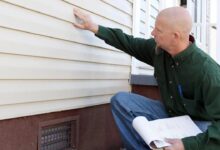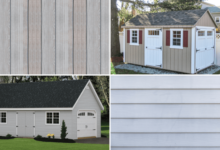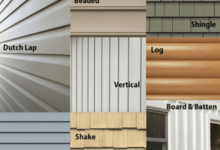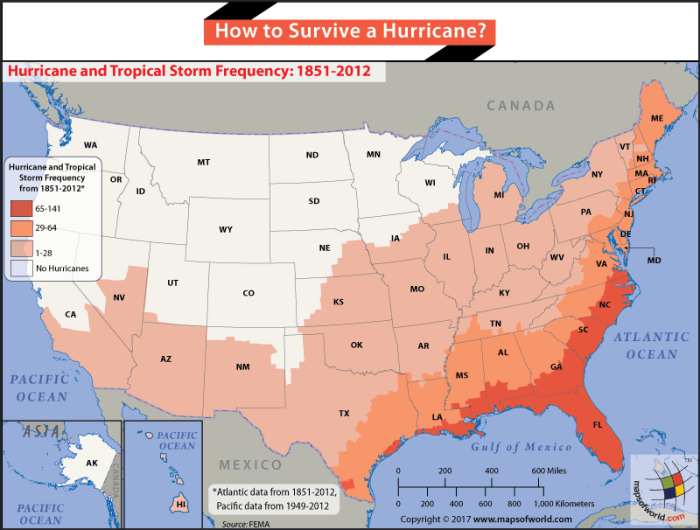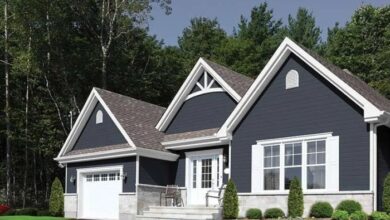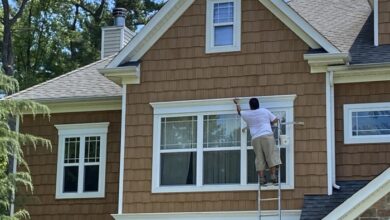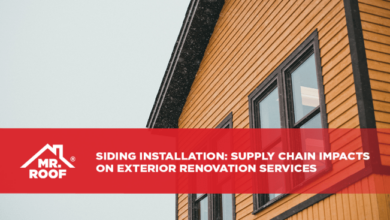Siding Material Comparison A Homeowners Guide
Siding Material Comparison: Choosing the right siding can dramatically impact your home’s curb appeal, longevity, and even its energy efficiency. This isn’t just about aesthetics; it’s a deep dive into the pros and cons of vinyl, wood, fiber cement, and metal siding – materials with wildly different properties, costs, and lifespans. Get ready to unlock the secrets to selecting the perfect siding for your dream home, factoring in everything from initial investment to long-term maintenance.
We’ll cut through the jargon and equip you with the knowledge to make an informed decision.
This comprehensive guide explores the key differences between popular siding materials, examining their durability, aesthetic versatility, installation complexities, environmental impact, and long-term maintenance needs. We’ll present clear comparisons, allowing you to weigh the benefits and drawbacks of each option against your specific needs and budget. Whether you’re a seasoned DIYer or relying on professional contractors, understanding these nuances is crucial for a successful and cost-effective siding project.
Introduction to Siding Materials
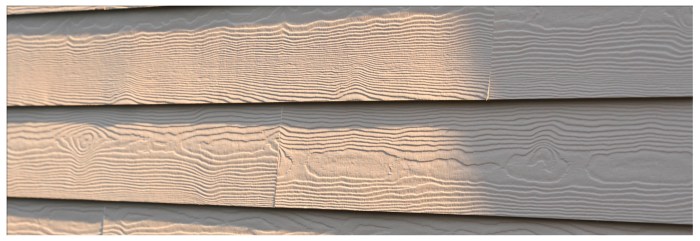
Choosing the right siding for your home is a crucial decision impacting both aesthetics and longevity. The market offers a diverse range of materials, each with unique properties influencing cost, durability, and maintenance requirements. Understanding these differences is key to making an informed choice that aligns with your budget and long-term goals. This section provides an overview of common siding materials, highlighting their characteristics and typical costs.Siding materials are broadly categorized based on their composition and manufacturing processes.
Popular choices include wood, vinyl, fiber cement, aluminum, and engineered wood. Each option presents a unique balance of cost, durability, and aesthetic appeal. For instance, wood siding offers a classic, natural look but requires significant maintenance to prevent rot and insect damage. Vinyl, on the other hand, is relatively low-maintenance and affordable, but it might not be as durable or aesthetically versatile as other options.
Fiber cement provides a robust and long-lasting solution, mimicking the look of wood while offering superior resistance to fire and pests. Aluminum siding is known for its lightweight nature and resistance to corrosion, making it a practical choice in coastal regions. Engineered wood siding combines the aesthetic appeal of natural wood with improved durability and resistance to moisture.
Common Siding Materials and Their Properties
The following table summarizes key characteristics of popular siding materials. Note that prices can vary significantly based on factors such as region, installer, and specific product features. These figures represent average initial costs and should be considered estimates.
| Siding Material | Initial Cost (per sq ft) | Durability | Maintenance |
|---|---|---|---|
| Wood | $7-$15 | Moderate (prone to rot and insect damage) | High (regular painting and sealing required) |
| Vinyl | $3-$8 | Good (resistant to rot and insects) | Low (easy to clean) |
| Fiber Cement | $8-$15 | Excellent (resistant to fire, rot, and insects) | Moderate (occasional cleaning and repainting) |
| Aluminum | $5-$10 | Good (resistant to corrosion) | Low (easy to clean) |
| Engineered Wood | $6-$12 | Good (improved resistance to moisture and insects) | Moderate (occasional cleaning and repainting) |
Initial Cost Comparison of Siding Materials
The initial cost of siding is a significant factor in the decision-making process. While vinyl typically offers the lowest upfront investment, the long-term cost of maintenance and potential premature replacement should be considered. For example, a homeowner choosing vinyl siding might save money initially, but may need to replace it sooner than more expensive options like fiber cement, negating the initial cost savings in the long run.
Conversely, the higher initial investment in materials like fiber cement or engineered wood often translates to lower long-term maintenance costs and a longer lifespan. Careful consideration of both initial and long-term costs is crucial for a financially sound decision.
Material Properties and Durability
Choosing the right siding for your home is a significant investment, impacting both its aesthetic appeal and long-term structural integrity. Understanding the material properties and durability of various siding options is crucial for making an informed decision. This section delves into the specifics of vinyl, wood, fiber cement, and metal siding, comparing their lifespans, maintenance needs, and resistance to the elements.
By weighing the pros and cons of each, you can confidently select the siding that best suits your needs and budget.
Vinyl Siding Properties and Durability
Vinyl siding offers a compelling blend of affordability and low maintenance. Its durability stems from its resistance to rot, insect infestation, and moisture damage. However, its susceptibility to damage from impacts and extreme temperature fluctuations should be considered. A properly installed vinyl siding system can easily last 20-30 years, often requiring minimal upkeep beyond occasional cleaning. Its resilience to wind and rain is generally high, but heavy snow accumulation might occasionally cause issues if not properly managed.
- Advantages: Affordable, low maintenance, resistant to rot and insects, relatively long lifespan.
- Disadvantages: Susceptible to impact damage, can fade in intense sunlight, may not be as aesthetically pleasing as other options to some homeowners.
Wood Siding Properties and Durability
Natural wood siding exudes timeless charm and character, offering a wide array of styles and finishes. However, this beauty comes at a cost – higher initial investment and significant ongoing maintenance. Wood’s susceptibility to rot, insect damage, and moisture absorption necessitates regular painting or staining to extend its lifespan, which typically ranges from 15-30 years, depending on the wood type and maintenance.
While it can withstand wind and rain, it’s more vulnerable to extreme weather conditions than other materials. Proper sealing and regular maintenance are critical to mitigating these vulnerabilities.
- Advantages: Aesthetically pleasing, natural look and feel, can be customized extensively.
- Disadvantages: High initial cost, requires regular maintenance (painting, staining), susceptible to rot, insects, and moisture damage.
Fiber Cement Siding Properties and Durability
Fiber cement siding strikes a balance between durability and aesthetic appeal. This composite material combines the strength of cement with the workability of wood fibers, resulting in a product that resists rot, insects, fire, and moisture. Its lifespan typically exceeds 30 years, with minimal maintenance needed beyond occasional cleaning. Its exceptional resistance to wind, rain, and snow makes it an ideal choice for harsh climates.
While more expensive than vinyl, its long lifespan and low maintenance requirements often offset the higher upfront cost.
- Advantages: Durable, long-lasting, fire-resistant, low maintenance, resistant to rot and insects.
- Disadvantages: Higher initial cost than vinyl, can be brittle and prone to cracking if improperly installed, heavier than other siding materials.
Metal Siding Properties and Durability
Metal siding, typically made of aluminum or steel, boasts exceptional durability and longevity. Its resistance to rot, insects, fire, and moisture damage is unparalleled. With proper installation, metal siding can last 40 years or more, requiring minimal maintenance. Its exceptional resistance to extreme weather conditions, including high winds and heavy snow, makes it a popular choice in areas prone to severe storms.
However, its susceptibility to dents and scratches should be considered. Furthermore, its contemporary look might not appeal to all styles of homes.
- Advantages: Extremely durable, long lifespan, resistant to fire, rot, insects, and moisture damage, excellent weather resistance.
- Disadvantages: Higher initial cost, can dent or scratch easily, may not be aesthetically pleasing to everyone.
Aesthetic Considerations and Design Options
Choosing the right siding not only protects your home but significantly impacts its overall aesthetic appeal. The interplay between siding material, color, texture, and architectural style can dramatically enhance or detract from your home’s curb appeal, influencing its perceived value and your enjoyment of the space. Careful consideration of these factors is crucial for achieving a cohesive and visually stunning exterior.The aesthetic appeal of different siding materials varies greatly depending on the architectural style of your home.
For instance, the clean lines and modern simplicity of fiber cement siding perfectly complement contemporary homes, while the rustic charm of wood siding adds character to traditional or farmhouse designs. Similarly, the sleekness of vinyl siding can enhance a ranch-style home, and the sophisticated look of brick siding can elevate a colonial or Victorian home. The choice depends on the desired visual effect and the overall harmony with the existing architectural elements.
Siding Material Aesthetics and Architectural Styles
Different siding materials offer a wide range of colors and textures, allowing for extensive customization to match individual preferences and architectural styles. Vinyl siding, for example, is available in a vast array of colors and textures, mimicking the look of wood, stone, or even stucco. Fiber cement siding offers a more natural, less overtly manufactured look, often available in earth tones and subtle textures.
Wood siding, in contrast, provides a highly varied palette, from rich, dark browns to light, weathered grays, with textures ranging from smooth to deeply textured depending on the wood type and finishing process. Metal siding offers sleek, contemporary looks, often in metallic shades or matte finishes. Brick, of course, boasts a classic and timeless appeal with its diverse color options and distinct textural properties.
When investigating detailed guidance, check out Sustainable Siding Materials now.
| House Style | Suitable Siding Materials | Color/Texture Examples | Curb Appeal Impact |
|---|---|---|---|
| Contemporary | Fiber Cement, Metal | Clean lines, neutral colors (gray, white, beige), smooth textures | Modern, sleek, sophisticated |
| Traditional | Wood, Brick | Warm earth tones (brown, tan), varied textures (rough-sawn, smooth), classic color palettes | Timeless elegance, classic charm |
| Farmhouse | Wood, Vinyl (wood-grain) | Light and weathered tones, rustic textures, muted colors | Rustic charm, welcoming feel |
| Ranch | Vinyl, Brick | Wide range of colors, smooth or slightly textured surfaces | Clean, simple, versatile |
The impact of siding material on curb appeal is significant. Consider a Victorian home clad in vibrant, mismatched vinyl siding; the result would clash dramatically with the architectural style. However, the same home sided with appropriately chosen wood siding, perhaps in a deep, rich brown with intricate detailing, would enhance its inherent elegance and grandeur. The correct siding choice can transform a house from ordinary to extraordinary, boosting its overall visual appeal and adding considerable value.
Conversely, an inappropriate choice can diminish a home’s aesthetic qualities, making it appear dated or out of place.
Installation and Cost Analysis: Siding Material Comparison
Choosing the right siding isn’t just about aesthetics; the installation process and associated costs significantly impact your overall budget and project timeline. Understanding these factors is crucial for making an informed decision that aligns with your financial resources and construction goals. This section will break down the installation complexities and cost implications for various siding materials, helping you navigate the financial landscape of your exterior renovation.
Installation complexity varies greatly depending on the siding material. Vinyl siding, for instance, is generally considered easy to install, requiring less specialized skill and tools compared to more complex materials like wood or fiber cement. This translates directly into labor costs; simpler installations mean lower labor expenses. Conversely, materials like stone or brick demand significantly more expertise and time, resulting in higher labor charges.
Material costs themselves also differ widely, influenced by factors such as material quality, thickness, and design features.
Installation Process Comparison
The installation process for different siding materials requires varying levels of expertise and specialized tools. Vinyl siding installation, often a DIY-friendly option, involves interlocking panels that are easily attached to the house’s framing. Wood siding, on the other hand, necessitates precision cuts, proper fastening techniques, and potentially specialized tools for intricate designs. Fiber cement siding, while durable, requires more careful handling and specialized fasteners due to its weight and potential for breakage.
Stone and brick require the most specialized labor, involving skilled masons and meticulous craftsmanship. Each material’s unique installation demands influence both the time and cost of the project.
Labor and Material Cost Breakdown
Labor costs are directly tied to the complexity of the installation process. Simple siding like vinyl typically involves lower labor costs per square foot, while more complex materials like stone or brick command significantly higher rates due to the specialized skills and time involved. Material costs are equally variable, reflecting differences in material quality, durability, and aesthetic features.
High-end wood siding, for example, will cost considerably more than standard vinyl siding. Consider factors like regional pricing variations and the current market conditions for materials when budgeting.
Total Cost Comparison of Siding Options
The table below provides a general comparison of the total cost, including both materials and labor, for different siding options. Note that these figures are estimates and can vary significantly based on factors such as project size, location, labor rates, and material choices. Always obtain multiple quotes from reputable contractors to get a more accurate cost assessment for your specific project.
| Siding Material | Material Cost per sq ft | Labor Cost per sq ft | Total Cost per sq ft |
|---|---|---|---|
| Vinyl | $2 – $5 | $3 – $6 | $5 – $11 |
| Wood | $6 – $20 | $7 – $15 | $13 – $35 |
| Fiber Cement | $8 – $15 | $8 – $12 | $16 – $27 |
| Brick | $15 – $30 | $15 – $30 | $30 – $60 |
| Stone | $20 – $50+ | $20 – $40+ | $40 – $90+ |
Factors Influencing Overall Cost
Several factors contribute to the overall cost of siding installation. Project size is a primary driver; larger projects naturally require more materials and labor, leading to higher costs. The complexity of the design, including intricate details or custom features, also impacts both material and labor expenses. Regional variations in labor rates and material availability can significantly influence the final price.
Finally, the chosen contractor’s experience and reputation also play a crucial role; experienced contractors may charge more but often provide higher quality work and minimize potential issues.
Environmental Impact and Sustainability
Choosing siding isn’t just about aesthetics and durability; it’s about making an environmentally conscious decision. The entire lifecycle of your siding – from material sourcing and manufacturing to its eventual disposal – significantly impacts the planet. Understanding these impacts is crucial for making an informed choice that aligns with your sustainability goals. This section delves into the environmental footprint of various siding materials, offering a clearer picture of their long-term consequences.The environmental impact of siding materials varies considerably, encompassing factors like resource depletion, energy consumption during manufacturing, transportation emissions, and end-of-life disposal challenges.
Some materials, like sustainably harvested wood, offer a lower carbon footprint compared to others with intensive manufacturing processes. Let’s examine these impacts in detail, considering the entire lifecycle.
Sourcing and Manufacturing Processes
The journey of siding materials from raw resource to finished product significantly influences their environmental impact. Wood siding, for instance, relies on forestry practices. Sustainable forestry, emphasizing replanting and responsible harvesting, minimizes deforestation and carbon emissions. Conversely, vinyl siding’s manufacturing involves petroleum-based plastics, contributing to greenhouse gas emissions. Fiber cement siding, a composite material, requires energy-intensive manufacturing processes, impacting its overall environmental footprint.
Metal siding, while often recyclable, depends on mining and refining processes, leading to potential environmental concerns related to resource extraction and waste generation. For example, aluminum production is energy-intensive, while steel production generates significant carbon emissions. The choice of material thus reflects a trade-off between different environmental concerns.
Recyclability and Sustainability
The recyclability and end-of-life management of siding materials are critical aspects of their sustainability. While wood siding can biodegrade, its disposal might still involve transportation and potential landfill space occupation. Vinyl siding, despite its durability, is not readily recyclable in many regions, often ending up in landfills, posing long-term environmental challenges. Fiber cement siding has limited recyclability, often requiring specialized processing.
Metal siding, in contrast, possesses higher recyclability rates, making it a more sustainable option from a material reuse perspective. However, the energy required for recycling must also be considered. The overall sustainability of each material is therefore determined by a complex interplay of factors including material sourcing, manufacturing, use-life, and end-of-life management.
Energy Efficiency Implications
Siding’s impact on a building’s energy efficiency is another key factor in its overall environmental footprint. Materials with high thermal resistance, like fiber cement and insulated vinyl siding, can reduce energy consumption for heating and cooling. This translates to lower greenhouse gas emissions associated with energy production. Conversely, materials with lower insulation values might increase energy demand, leading to a higher carbon footprint over the building’s lifespan.
For example, a house with well-insulated fiber cement siding might require less energy for climate control compared to a similar house with thin vinyl siding. This difference can be significant over the building’s lifetime, affecting its overall environmental impact. The choice of siding, therefore, impacts not only the initial environmental impact of manufacturing and installation but also the ongoing operational energy consumption of the building.
Maintenance and Repair
Choosing the right siding isn’t just about initial cost; long-term maintenance significantly impacts the overall expense and lifespan of your home’s exterior. Understanding the upkeep required for each material is crucial for informed decision-making. This section delves into the maintenance and repair needs of various siding types, helping you anticipate and budget for future expenses.Maintaining your home’s siding is essential for preserving its aesthetic appeal and structural integrity.
Neglecting routine maintenance can lead to costly repairs down the line, potentially impacting your home’s value. Regular cleaning and prompt attention to minor damage are key to extending the life of your siding.
Siding Material Maintenance Comparison
This comparison Artikels the maintenance requirements for common siding materials, including cleaning, repair frequency, and associated costs. We’ll examine the practical aspects, providing a realistic overview of what homeowners can expect.
| Siding Material | Cleaning Frequency | Common Repairs | Repair Cost (Estimate) |
|---|---|---|---|
| Vinyl | Annual pressure washing | Crack repair, replacement of damaged panels | $50 – $200 per repair, depending on extent of damage |
| Wood | Semi-annual cleaning, occasional staining/sealing | Rot repair, replacement of damaged boards, repainting | $100 – $500 per repair, potentially higher for extensive rot |
| Fiber Cement | Annual cleaning, occasional caulking | Crack repair, replacement of damaged panels | $100 – $300 per repair, depending on panel size and location |
| Metal | Annual cleaning, occasional touch-up paint | Dent repair, replacement of damaged panels | $50 – $150 per repair, depending on extent of damage |
Common Repair Methods
Effective repair techniques vary depending on the siding material and the nature of the damage. Addressing problems promptly minimizes further damage and reduces long-term costs. For instance, a small crack in vinyl siding might only require patching, while extensive rot in wood siding necessitates board replacement.
Vinyl Siding Repair: Minor cracks can often be repaired with caulk or vinyl patching kits. Larger damaged sections typically require panel replacement. This often involves carefully removing the damaged section and installing a new one, ensuring proper alignment and sealing. Proper preparation is key for long-lasting repairs.
Wood Siding Repair: Rot repair in wood siding often involves cutting out the affected area and replacing it with new wood. This process requires carpentry skills or professional assistance. Repainting or restaining is usually necessary after repairs to maintain the aesthetic appeal.
Fiber Cement Siding Repair: Minor cracks in fiber cement siding can sometimes be filled with caulk. Larger damages usually necessitate panel replacement. This often requires careful removal of the damaged panel and installation of a new one. Accurate color matching of the new panel is important for a seamless finish.
Metal Siding Repair: Dents in metal siding can sometimes be repaired by carefully pushing the dent out from the back. More significant damage, such as holes or severe bending, usually requires panel replacement. This often involves careful removal and replacement of the affected panel.
Maintenance Cost Over Lifespan, Siding Material Comparison
The cumulative cost of maintenance and repairs varies considerably among siding materials. While vinyl siding generally requires less maintenance, the initial lower cost might be offset by the need for more frequent replacements due to potential cracking or fading over time. Conversely, while wood siding demands more upkeep, its durability can make it a cost-effective choice in the long run, particularly if properly maintained.
Fiber cement and metal sidings offer a good balance between initial cost and long-term maintenance needs. Factors such as climate and exposure to the elements also influence maintenance expenses. For example, coastal homes exposed to salt spray might require more frequent cleaning and repairs compared to those in more sheltered locations.
Tools and Supplies for Siding Maintenance
Proper tools and supplies are essential for effective siding maintenance. Having the right equipment ensures efficient and safe work, minimizing the risk of damage and extending the life of your siding.
The necessary tools and supplies can vary depending on the siding material and the type of maintenance being performed. However, some common items include:
- Ladder (appropriate height and stability)
- Pressure washer (for cleaning)
- Cleaning solutions (appropriate for siding material)
- Caulk and caulking gun (for sealing)
- Putty knife or scraper (for removing loose paint or debris)
- Paintbrushes or rollers (for repainting or restaining)
- Safety glasses and gloves
- Replacement siding panels (if needed)
- Measuring tape and level
- Screwdrivers and other hand tools (for repairs)
Choosing the Right Siding Material
Selecting the ideal siding for your home involves a multifaceted decision-process, going beyond mere aesthetics. The optimal choice hinges on a careful consideration of various factors, ensuring both long-term durability and alignment with your personal preferences and budget. Ignoring these factors can lead to costly repairs, reduced curb appeal, and even structural issues down the line.
Climate Considerations in Siding Selection
Climate plays a pivotal role in siding material longevity and performance. Extreme temperature fluctuations, high humidity, and heavy snowfall all impact material durability. For instance, wood siding, while aesthetically pleasing, requires regular maintenance in regions with high humidity to prevent rot and insect infestation. In contrast, vinyl siding, known for its low maintenance, might warp or fade under prolonged exposure to intense sunlight in arid climates.
Conversely, fiber cement siding offers excellent resistance to both extreme temperatures and moisture, making it a suitable choice for diverse climates. Understanding your local climate is crucial for making an informed decision. A thorough assessment of average temperatures, rainfall, snowfall, and humidity levels will significantly narrow down your siding material options.
Siding Material Choices for Varying Budgets and Home Styles
Budget significantly influences siding material selection. Vinyl siding represents a cost-effective solution, offering a wide range of colors and styles to suit various home aesthetics. However, for a more premium look and enhanced durability, fiber cement or engineered wood siding might be preferable, despite their higher initial cost. The choice also depends on the architectural style of your home.
A traditional Victorian home might be best complemented by wood or fiber cement siding, while a modern minimalist design could pair well with sleek metal or vinyl options. For example, a budget-conscious homeowner renovating a ranch-style house might opt for vinyl siding for its affordability and ease of installation, whereas a homeowner renovating a historic colonial home might prioritize the durability and aesthetic appeal of cedar or fiber cement siding, despite the higher cost.
Compliance with Local Building Codes and Regulations
Adhering to local building codes and regulations is non-negotiable. These regulations often specify acceptable siding materials, fire-resistance requirements, and installation standards. Ignoring these guidelines can lead to delays in the permitting process, potential fines, and even structural vulnerabilities. Before finalizing your siding choice, thoroughly research your local building codes and regulations, or consult with a building inspector to ensure compliance.
For instance, some regions may mandate the use of fire-resistant siding materials in areas prone to wildfires.
A Step-by-Step Guide to Siding Material Selection
The selection process can be streamlined by following a structured approach. First, assess your budget and desired aesthetic. Next, consider your climate and its impact on different materials. Third, research local building codes and regulations. Fourth, compare the properties and maintenance requirements of various siding materials.
Finally, obtain quotes from multiple contractors to compare costs and timelines. This systematic approach ensures a well-informed and efficient decision-making process. This meticulous approach minimizes the risk of costly mistakes and ensures the long-term success of your siding project.
Ending Remarks
Ultimately, the best siding material depends on your individual priorities. While initial cost is a significant factor, consider the long-term implications: maintenance needs, lifespan, and energy efficiency. Weighing the advantages and disadvantages of vinyl, wood, fiber cement, and metal siding, as detailed in this comparison, will empower you to make a smart, informed choice that enhances your home’s value and reflects your personal style for years to come.
Remember to factor in your climate, budget, and aesthetic preferences for a truly optimized selection. Your dream home awaits!

